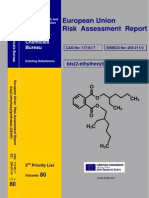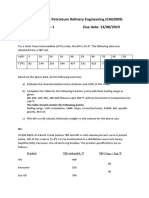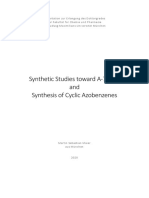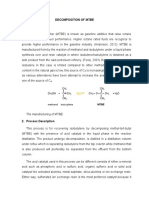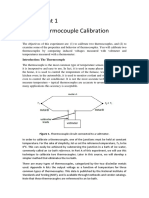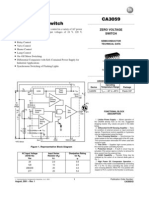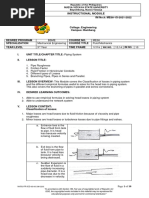Octane Number
Uploaded by
IbrahimOctane Number
Uploaded by
IbrahimPetroleum Refinery Lab
Experiment No. 4
Standard Test Method for
Research Octane Number of Spark-Ignition Engine Fuel, D2699
Objective: quantitative determination of the knock rating of liquid spark-ignition engine fuel in
terms of Octane number.
Theory:
Octane Number is defined as the volume percentage of iso octane in blend of normal heptane
and iso-octane, which produces the same knock intensity as the test fuel under standard test
conditions in an ASTM internal combustion engine.
The key indication of performance property of gasoline under various engine conditions is its
octane number (ON) which included: Research Octane Number (RON) and Motor Octane
Number (MON).Finished gasoline must meet certain octane number specifications.
To determine octane number of gasoline an engine test is carried out at two different speeds
and the octane umber are defined as the research octane number (RON) and the motor octane
number (MON), which are conducted at two different speeds, 600 and 900 rpm, respectively.
MON is always less than RON for the same fuel. Octane number shown on pumps at fuel
stations is the average of RON and MON.
Research and Motor Octane numbers (RON, MON) constitute the main quality characteristics of
the gasoline, as they provide a sensitive indication of the anti-knocking behavior of the fuel. The
higher the octane number the better the gasoline resists detonation and the smoother the
engine runs.
Antiknock Index (AKI) or Pump Octane Number (PON; sometimes Posted Octane Number) is a
measure of a fuel’s ability to resist engine knock or octane quality. The AKI is an arithmetic
average of RON and MON. The AKI of a motor fuel is the average of the RON and MON as
determined by the formula (R+M)/2.
Anti-knock additives:
1. Oxygenates: ethers—methyl tertiary-butyl ether (MTBE), ethyl tertiary-butyl ether
(ETBE), tertiary-amyl methyl ether (TAME), di-isopropyl ether (DIPE); alcohols—
methanol, ethanol, tertiary butyl alcohol (TBA).
2. Aromatic hydrocarbons (aromatics): toluene, xylene, and benzene. The latter is toxic
(including carcinogenicity) and therefore its amount is restricted by 1 % vol. Maximum
allowable concentration of aromatics in gasoline is 35 % vol.
3. Aromatic amines: m-toluidine, p-toluidine, p-tert-butylaniline, technical
pseudocumidine, N-methylaniline, and cumidines.
4. Organometallic compounds : Like the first anti-knock additive tetra-ethyl lead (TEL) is
based on Pb, these additives also are based on metals Mn and Fe.
Petrochemical Dept. Page 1
Petroleum Refinery Lab
Digital Octane Tester K 88600 XL:
Apparatus Description:
Other parts:
Petrochemical Dept. Page 2
Petroleum Refinery Lab
Discussion:
1. Define Octane number.
2. Why do we measure octane number of gasoline?
3. Which hydrocarbons have highest ON and which one has the lowest?
4. What is meant by RON, MON and AKI?
5. How can gasoline ON be increased?
Petrochemical Dept. Page 3
Petroleum Refinery Lab
Worksheet
Experiment no.:
Title: Octane Number
Name:
Class:
Date:
Sample 1
RON =
MON =
AKI =
Sample 2
RON =
MON =
AKI =
Petrochemical Dept. Page 4
You might also like
- Electric Nail File Training Manual 2021No ratings yetElectric Nail File Training Manual 202124 pages
- Acmc-Qaqc-001 - Quality Observation Report Form - QorNo ratings yetAcmc-Qaqc-001 - Quality Observation Report Form - Qor12 pages
- Gasoline Octane Number Improvement by Ethanol As An Oxygenated CompoundNo ratings yetGasoline Octane Number Improvement by Ethanol As An Oxygenated Compound8 pages
- Ionic Liquid-Assisted Refinery Processes - A Review and Industrial PerspectiveNo ratings yetIonic Liquid-Assisted Refinery Processes - A Review and Industrial Perspective23 pages
- Ionic Liquids For Extraction Processes in Refinery-Related ApplicationsNo ratings yetIonic Liquids For Extraction Processes in Refinery-Related Applications27 pages
- Determining Water Separation Characteristics of Aviation Turbine Fuels by Portable SeparometerNo ratings yetDetermining Water Separation Characteristics of Aviation Turbine Fuels by Portable Separometer13 pages
- The Use of Ionic Liquids Based On Choline Chloride For MetalNo ratings yetThe Use of Ionic Liquids Based On Choline Chloride For Metal8 pages
- Furfural A Selective Solvent Petroleum Refining: Kemp, JR.No ratings yetFurfural A Selective Solvent Petroleum Refining: Kemp, JR.8 pages
- Kerosene Isosiv Process For Production of Normal Paraffins: Stephen W. SohnNo ratings yetKerosene Isosiv Process For Production of Normal Paraffins: Stephen W. Sohn6 pages
- Toluene Toluene Toluene Hydrogen Chromium PlatinumNo ratings yetToluene Toluene Toluene Hydrogen Chromium Platinum6 pages
- Acetic Anhydride Production Process - Monsanto Process For Acetic Acid Synthesis - Chem-Station ... - Minor Outlets For The Chemical Include Acetylation Reactions in Organic Chemistry. - Dualipan - 5No ratings yetAcetic Anhydride Production Process - Monsanto Process For Acetic Acid Synthesis - Chem-Station ... - Minor Outlets For The Chemical Include Acetylation Reactions in Organic Chemistry. - Dualipan - 52 pages
- Recovery of Ammonia As Struvite From Anaerobic Digester EffluentsNo ratings yetRecovery of Ammonia As Struvite From Anaerobic Digester Effluents11 pages
- Liquid Extraction Unit Operations ReviewNo ratings yetLiquid Extraction Unit Operations Review10 pages
- Feasibility Study of Ethylene Vinyl Acetate ProductionNo ratings yetFeasibility Study of Ethylene Vinyl Acetate Production3 pages
- SSCHE 14 075 Kralik Aniline Catalysis and CHemEngngNo ratings yetSSCHE 14 075 Kralik Aniline Catalysis and CHemEngng13 pages
- Concawe REACH - Analytical Characterisation of Petroleum UVCB SubstancesNo ratings yetConcawe REACH - Analytical Characterisation of Petroleum UVCB Substances118 pages
- Phosgene-Free Route To Toluene DiisocyanateNo ratings yetPhosgene-Free Route To Toluene Diisocyanate399 pages
- Chemical Kinetics On Thermal Decompositions of CumeneNo ratings yetChemical Kinetics On Thermal Decompositions of Cumene8 pages
- Dehydrogenation by Heterogeneous CatalystsNo ratings yetDehydrogenation by Heterogeneous Catalysts52 pages
- References:: Production of Phenol and Acetone by Cumene Peroxidation ProcessNo ratings yetReferences:: Production of Phenol and Acetone by Cumene Peroxidation Process6 pages
- Feedstock Recycling and Pyrolysis of Waste Plastics - IndexNo ratings yetFeedstock Recycling and Pyrolysis of Waste Plastics - Index30 pages
- SINOPEC Methanol-To-Olefins (S-MTO) Technology Process PDFNo ratings yetSINOPEC Methanol-To-Olefins (S-MTO) Technology Process PDF1 page
- Henry's Law Constants Publishedl VersionNo ratings yetHenry's Law Constants Publishedl Version10 pages
- Comparison of Ionic Liquids To Conventional Organic Solvents For Extraction of Aromatics From AliphaticsNo ratings yetComparison of Ionic Liquids To Conventional Organic Solvents For Extraction of Aromatics From Aliphatics15 pages
- Modeling of Growth and Energy Metabolism of Pichia Pastoris Producing A Fusion ProteinNo ratings yetModeling of Growth and Energy Metabolism of Pichia Pastoris Producing A Fusion Protein9 pages
- 3 Fluoroelastomer Monomers 2006 Fluoroelastomers Handbook100% (1)3 Fluoroelastomer Monomers 2006 Fluoroelastomers Handbook12 pages
- Handbook of Polymer Synthesis, Characterization, and ProcessingFrom EverandHandbook of Polymer Synthesis, Characterization, and ProcessingNo ratings yet
- Ibrahim Dewali Arab: Petrochemicals Engineering StudentNo ratings yetIbrahim Dewali Arab: Petrochemicals Engineering Student1 page
- Experiment 1 Thermocouple Calibration: ObjectivesNo ratings yetExperiment 1 Thermocouple Calibration: Objectives3 pages
- Plant Design 4th Year Ahmed Tahseen Petrochemical Engineering1615515478313908072No ratings yetPlant Design 4th Year Ahmed Tahseen Petrochemical Engineering16155154783139080723 pages
- Duhok Polytechnic University Technical College of Engineering Petrochemical DepartmentNo ratings yetDuhok Polytechnic University Technical College of Engineering Petrochemical Department4 pages
- Approximations and Errors in Numerical Analysis: Dr. Ammar Isam EdressNo ratings yetApproximations and Errors in Numerical Analysis: Dr. Ammar Isam Edress34 pages
- A Turbine Flow Meter Is A Widely Used Tool For Measuring The Rate of Flow of A Given FluidakamNo ratings yetA Turbine Flow Meter Is A Widely Used Tool For Measuring The Rate of Flow of A Given Fluidakam10 pages
- Process Instrumentation Third YEAR LevelNo ratings yetProcess Instrumentation Third YEAR Level2 pages
- Single Compartment-Compact Roll-In Retarder-Proofer: Performances UseNo ratings yetSingle Compartment-Compact Roll-In Retarder-Proofer: Performances Use3 pages
- Technician Jailed Over Accident That Saw Trapped Worker Bleed To Death in Lift ShaftNo ratings yetTechnician Jailed Over Accident That Saw Trapped Worker Bleed To Death in Lift Shaft4 pages
- Xps Studies For Nacl Deposited On The Ni (Ll1) SurfaceNo ratings yetXps Studies For Nacl Deposited On The Ni (Ll1) Surface10 pages
- 7230G分光光度计操作步序Spectrophotometer operation proceduresNo ratings yet7230G分光光度计操作步序Spectrophotometer operation procedures3 pages
- Crack Control For Concrete Brick and Masonry Veneer (NCMA TEK 10-4)No ratings yetCrack Control For Concrete Brick and Masonry Veneer (NCMA TEK 10-4)4 pages
- SQF-RAMS-LIN-EL-03 - Cable and Wire PullingNo ratings yetSQF-RAMS-LIN-EL-03 - Cable and Wire Pulling31 pages
- Aeolian Vibration: Leksono Hartanto PLP IndonesiaNo ratings yetAeolian Vibration: Leksono Hartanto PLP Indonesia31 pages
- L4 Storage and Flow of Powder-Part 4 PDFNo ratings yetL4 Storage and Flow of Powder-Part 4 PDF25 pages
- Unified Homework First Exam T3 - TODO JUNTONo ratings yetUnified Homework First Exam T3 - TODO JUNTO8 pages
- 193504905-LTE-Optimization Question and Answer For Interview100% (1)193504905-LTE-Optimization Question and Answer For Interview18 pages
- General and Charger Rules 2015 Holland Motorsports ComplexNo ratings yetGeneral and Charger Rules 2015 Holland Motorsports Complex23 pages
- 3-Roll Plate Bending/Rolling Machine: Working Principle & The Rolling ProcessNo ratings yet3-Roll Plate Bending/Rolling Machine: Working Principle & The Rolling Process5 pages
- Acmc-Qaqc-001 - Quality Observation Report Form - QorAcmc-Qaqc-001 - Quality Observation Report Form - Qor
- Gasoline Octane Number Improvement by Ethanol As An Oxygenated CompoundGasoline Octane Number Improvement by Ethanol As An Oxygenated Compound
- Ionic Liquid-Assisted Refinery Processes - A Review and Industrial PerspectiveIonic Liquid-Assisted Refinery Processes - A Review and Industrial Perspective
- Ionic Liquids For Extraction Processes in Refinery-Related ApplicationsIonic Liquids For Extraction Processes in Refinery-Related Applications
- Determining Water Separation Characteristics of Aviation Turbine Fuels by Portable SeparometerDetermining Water Separation Characteristics of Aviation Turbine Fuels by Portable Separometer
- The Use of Ionic Liquids Based On Choline Chloride For MetalThe Use of Ionic Liquids Based On Choline Chloride For Metal
- Furfural A Selective Solvent Petroleum Refining: Kemp, JR.Furfural A Selective Solvent Petroleum Refining: Kemp, JR.
- Kerosene Isosiv Process For Production of Normal Paraffins: Stephen W. SohnKerosene Isosiv Process For Production of Normal Paraffins: Stephen W. Sohn
- Toluene Toluene Toluene Hydrogen Chromium PlatinumToluene Toluene Toluene Hydrogen Chromium Platinum
- Acetic Anhydride Production Process - Monsanto Process For Acetic Acid Synthesis - Chem-Station ... - Minor Outlets For The Chemical Include Acetylation Reactions in Organic Chemistry. - Dualipan - 5Acetic Anhydride Production Process - Monsanto Process For Acetic Acid Synthesis - Chem-Station ... - Minor Outlets For The Chemical Include Acetylation Reactions in Organic Chemistry. - Dualipan - 5
- Recovery of Ammonia As Struvite From Anaerobic Digester EffluentsRecovery of Ammonia As Struvite From Anaerobic Digester Effluents
- Feasibility Study of Ethylene Vinyl Acetate ProductionFeasibility Study of Ethylene Vinyl Acetate Production
- SSCHE 14 075 Kralik Aniline Catalysis and CHemEngngSSCHE 14 075 Kralik Aniline Catalysis and CHemEngng
- Concawe REACH - Analytical Characterisation of Petroleum UVCB SubstancesConcawe REACH - Analytical Characterisation of Petroleum UVCB Substances
- Chemical Kinetics On Thermal Decompositions of CumeneChemical Kinetics On Thermal Decompositions of Cumene
- References:: Production of Phenol and Acetone by Cumene Peroxidation ProcessReferences:: Production of Phenol and Acetone by Cumene Peroxidation Process
- Feedstock Recycling and Pyrolysis of Waste Plastics - IndexFeedstock Recycling and Pyrolysis of Waste Plastics - Index
- SINOPEC Methanol-To-Olefins (S-MTO) Technology Process PDFSINOPEC Methanol-To-Olefins (S-MTO) Technology Process PDF
- Comparison of Ionic Liquids To Conventional Organic Solvents For Extraction of Aromatics From AliphaticsComparison of Ionic Liquids To Conventional Organic Solvents For Extraction of Aromatics From Aliphatics
- Modeling of Growth and Energy Metabolism of Pichia Pastoris Producing A Fusion ProteinModeling of Growth and Energy Metabolism of Pichia Pastoris Producing A Fusion Protein
- 3 Fluoroelastomer Monomers 2006 Fluoroelastomers Handbook3 Fluoroelastomer Monomers 2006 Fluoroelastomers Handbook
- Handbook of Polymer Synthesis, Characterization, and ProcessingFrom EverandHandbook of Polymer Synthesis, Characterization, and Processing
- Ibrahim Dewali Arab: Petrochemicals Engineering StudentIbrahim Dewali Arab: Petrochemicals Engineering Student
- Plant Design 4th Year Ahmed Tahseen Petrochemical Engineering1615515478313908072Plant Design 4th Year Ahmed Tahseen Petrochemical Engineering1615515478313908072
- Duhok Polytechnic University Technical College of Engineering Petrochemical DepartmentDuhok Polytechnic University Technical College of Engineering Petrochemical Department
- Approximations and Errors in Numerical Analysis: Dr. Ammar Isam EdressApproximations and Errors in Numerical Analysis: Dr. Ammar Isam Edress
- A Turbine Flow Meter Is A Widely Used Tool For Measuring The Rate of Flow of A Given FluidakamA Turbine Flow Meter Is A Widely Used Tool For Measuring The Rate of Flow of A Given Fluidakam
- Single Compartment-Compact Roll-In Retarder-Proofer: Performances UseSingle Compartment-Compact Roll-In Retarder-Proofer: Performances Use
- Technician Jailed Over Accident That Saw Trapped Worker Bleed To Death in Lift ShaftTechnician Jailed Over Accident That Saw Trapped Worker Bleed To Death in Lift Shaft
- Xps Studies For Nacl Deposited On The Ni (Ll1) SurfaceXps Studies For Nacl Deposited On The Ni (Ll1) Surface
- 7230G分光光度计操作步序Spectrophotometer operation procedures7230G分光光度计操作步序Spectrophotometer operation procedures
- Crack Control For Concrete Brick and Masonry Veneer (NCMA TEK 10-4)Crack Control For Concrete Brick and Masonry Veneer (NCMA TEK 10-4)
- 193504905-LTE-Optimization Question and Answer For Interview193504905-LTE-Optimization Question and Answer For Interview
- General and Charger Rules 2015 Holland Motorsports ComplexGeneral and Charger Rules 2015 Holland Motorsports Complex
- 3-Roll Plate Bending/Rolling Machine: Working Principle & The Rolling Process3-Roll Plate Bending/Rolling Machine: Working Principle & The Rolling Process

















